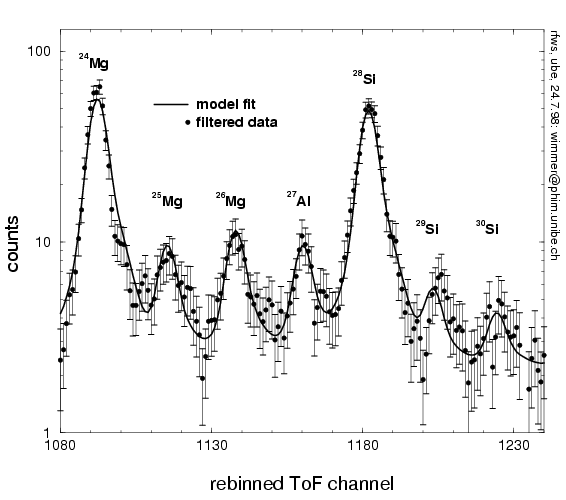August 6, 1998
Solar Wind Isotopes in the May 3, 1998 CME: SWIMS Data


It is currently thought that the acceleration of solar energetic particles (SEPs) in "gradual" events takes place at a shock driven by a coronal mass ejection (CME) moving out through the corona into the interplanetary medium. The actual source of the accelerated material is a subject of controversy, but among the possibilities are ambient coronal material, CME material, and solar wind. It has recently been reported that isotopic composition of SEPs accelerated to energies >10 MeV/nuc is sometimes enriched in heavy isotopes such as 22Ne and 26Mg relative to lighter isotopes such as 20Ne and 24Mg (e.g., the event in ACE News #5). To date there are no reported observations of whether the CME itself is enriched in heavy isotopes.
Data from the SWIMS instrument on ACE can address this issue. The data in the figure above were accumulated on May 3, 1998, during the second half of an unusual CME (see ACE News #16). The observed time-of-flight (ToF) distribution has been fit with a function that models the instrument response. Preliminary analysis of the isotopic composition of magnesium in this CME reveals very little or no enhancement of the heavier isotopes, 25Mg and 26Mg, with respect to the main isotope, 24Mg.
As the Sun approaches its activity maximum, we anticipate many more events like this. With the new instrumentation on ACE it should be possible to relate the isotopic abundances of SEPs observed over a wide range of energies to the abundances of possible seed populations observed at solar wind energies.
Contributed by Robert F. Wimmer-Schweingruber, University of Bern, Switzerland.
See The SWICS and SWIMS Home Page at the University of Michigan for more information about the SWIMS instrument.
Last modified 6 August 1998,
Andrew Davis
Return to ACE homepage.
/ACE/